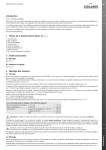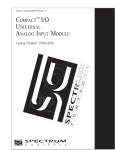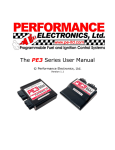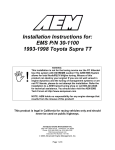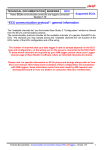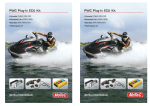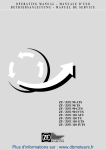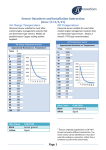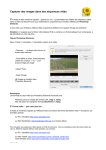Download User`s Manual
Transcript
User’s Guide Racing Car Diagnostic Display for Racing Engine Management Systems Technical support MechatroMotive Ltd. Web: www.MechatroMotive.com E-mail: [email protected] Balázs Varga +36 30 476 24 31 Released 28/05/2015 User’s Guide - RCD Display Table of contents 1. Introduction.................................................................................................................4 2. Overview ....................................................................................................................4 3. 2.1. Main functions ......................................................................................................4 2.2. Inputs ...................................................................................................................4 2.3. Technological parameters ....................................................................................5 Installation and wiring .................................................................................................6 3.1. Connectors...........................................................................................................8 3.1.1. Main Connector 1 ........................................................................................8 3.1.2. Main Connector 2 ........................................................................................9 3.1.3. Keyboard Connector ................................................................................. 11 4. Standard features ..................................................................................................... 12 5. Connecting engine management system .................................................................. 16 6. 5.1. DTA.................................................................................................................... 16 5.2. Link .................................................................................................................... 17 5.3. MoTeC ............................................................................................................... 23 5.3.1. MoTeC M800 and other MoTeC ECUs with CRC32 protocol .................... 23 5.3.2. MoTeC M4 ................................................................................................ 33 5.4. Syvecs ............................................................................................................... 40 5.5. Vi-PEC ............................................................................................................... 51 5.5.1. VTS ........................................................................................................... 51 5.5.2. iVTS .......................................................................................................... 58 5.6. VEMS................................................................................................................. 62 5.7. None .................................................................................................................. 64 Connecting sensors .................................................................................................. 65 6.1. 7. Connecting analog sensors ................................................................................ 65 6.1.1. Passive sensors ........................................................................................ 66 6.1.2. NTC .......................................................................................................... 67 6.1.3. PT100-PT1000 .......................................................................................... 67 6.2. Connecting switch sensors ................................................................................. 68 6.3. Connecting impulse type sensors ....................................................................... 68 6.4. Connecting the thermocouples ........................................................................... 68 Configuration Options ............................................................................................... 69 7.1. Entering data...................................................................................................... 69 7.2. Setting the alerts ................................................................................................ 70 7.3. RPM LED bar setting ......................................................................................... 73 www.mechatromotive.com 2/89 User’s Guide - RCD Display 7.4. Brightness setting............................................................................................... 74 7.5. Analog parameters ............................................................................................. 75 7.6. Defining a calibration equation for analog sensors ............................................. 76 7.7. Others ................................................................................................................ 79 7.7.1. Setting the impulses .................................................................................. 79 7.7.2. Fullscreen warning .................................................................................... 80 7.7.3. ECU type................................................................................................... 80 7.7.4. Start screen............................................................................................... 80 7.7.5. DTA gear by shaft ..................................................................................... 80 7.7.6. Load defaults ............................................................................................ 80 8. Firmware update....................................................................................................... 81 9. Safety regulations ..................................................................................................... 85 10. Figures list ................................................................................................................ 86 11. Tables list ................................................................................................................. 89 www.mechatromotive.com 3/89 User’s Guide - RCD Display 1. Introduction RCD Display is a universal display panel, which can visualize data from sensors attached, and can communicate with the engine controller unit. The RCD Display can communicate with ECUs via CAN buses. Supported types: DTA o S40 PRO o S60 PRO o S80 PRO o S100 PRO Link o G4 storm MoTeC o all ECUs with CRC32 protocol o M4 VEMS Syvecs Vi-PEC Vi-PEC o VTS (v10000 or later) o iVTs 2. Overview 2.1. Main functions Display 5,7" 320 x 240 pixel Different screens Programmable RPM LED bar External control panel Communicating: CAN, RS232 User defined limits Flexible sensor calibration 2.2. Inputs 2 pcs “K” typ. thermocouple 6 pcs Analogs 0-15V 5 pcs Digital input (buttons) 4 pcs General digital input www.mechatromotive.com 4/89 User’s Guide - RCD Display 1 pcs Phototransistor 1 pcs CAN 1 pcs RS232 2.3. Technological parameters Dimensions: 198 x 130 x 36 mm Voltage: 10 V - 15 V Power consumption: 1 A Size of display: 5,7 ” Resolution: 320 x 240 pixel Frequency of freshening: 60 Hz Color depth of display: 256 bit Maximal brightness: 800 cd/m2 Contrast Ratio: 800 : 1 Operating temperature range: -20 °C – °60 C www.mechatromotive.com 5/89 User’s Guide - RCD Display 3. Installation and wiring Be careful when you install the panel, use vibration resistant self-locking nuts! When routing the cables, ensure of their integrity, avoid contact with moving parts of the vehicle! With the supplied pins you can carry out the necessary wiring. Be sure to connect the connectors at the back of the panel and the wiring harness to the appropriate place! 1. Figure - Main connectors www.mechatromotive.com 6/89 User’s Guide - RCD Display 2. Figure - Mounting dimensions of the main unit 3. Figure - Navigation panel mounting dimensions www.mechatromotive.com 7/89 User’s Guide - RCD Display 3.1. Connectors 3.1.1. Main Connector 1 4. Figure – Main Connector 1 Pin No. Function with ECU Function without ECU 1 12V_In 2 12V_In 3 5V_Out_Ref 4 5V_Out_Ref 5 NC 6 Temperature_K_1 (Positive) 7 Temperature_K_2 (Positive) 8 Analog_Input_0V-15V_1 Fuel level 9 Analog_Input_0V-15V_2 Manifold Absolute Pressure 10 Analog_Input_0V-15V_3 Water temperature 11 Analog_Input_0V-15V_4 Oil temperature 12 Analog_Input_0V-15V_5 Fuel pressure 13 Analog_Input_0V-15V_6 Oil pressure 14 NC www.mechatromotive.com K_1 8/89 User’s Guide - RCD Display 15 Analog_GND 16 Analog_GND 17 GND 18 GND 19 CAN_H 20 CAN_L 1. Table - Main Connector 1 pinout 3.1.2. Main Connector 2 5. Figure - Main Connector 2 Pin No. Function Function without ECU 1 12V_In 2 Keyboard_Sw_5 3 Keyboard_Sw_4 4 Keyboard_Sw_3 5 Keyboard_Sw_2 6 Keyboard_Sw_1 7 Impulse_1 Engine rpm 8 Impulse_2 Vehicle speed www.mechatromotive.com 9/89 User’s Guide - RCD Display 9 Impulse_3 10 RS232_RX 11 RS232_TX 12 Digital_Input_1 13 Digital_Input_2 14 Digital_Input_3 15 Digital_Input_4 16 NC 17 NC 18 NC 19 NC 20 GND 2. Table - Main Connector 2 pinout The input cables of Pin 2-6 are the cables of the Keyboard Connector. These cables can be colored or numbered, as you can see in the 3.Table- Keyboard Connector pinout. www.mechatromotive.com 10/89 User’s Guide - RCD Display 3.1.3. Keyboard Connector Male connector to navigation panel (Micro-Fit Jr.) 6. Figure – Keyboard Connector (Male) Female connector to the wiring harness side (Micro-Fit Jr.) 7. Figure - Keyboard Connector (Female) 8-wire gray double-insulated round cable. The cables can be colored or numbered. Pin No. Function Color of the cable Number of the cable 1 12V+ Red 6 2 GND Gray yellow-green 3 NC White - 4 SW_1 Blue 5 5 SW_2 Yellow 4 6 SW_3 Brown 3 7 SW_4 Green 2 8 SW_5 Pink 1 3. Table - Keyboard Connector pinout www.mechatromotive.com 11/89 User’s Guide - RCD Display 4. Standard features For handling the display use the external control panel. Using the buttons you can switch between screens, enter data and perform settings. Menu Structure MAIN MENU o o o RUN RACE WINDOW STREET WINDOW WARM UP WINDOW DIAG 1 WINDOW DIAG 2 WINDOW DIAG 3 WINDOW DEMO RACE WINDOW STREET WINDOW WARM UP WINDOW DIAG 1 WINDOW DIAG 2 WINDOW DIAG 3 WINDOW SETUP LOWER LIMITS UPPER LIMITS LED RANGES BRIGHTNESS ANALOGS OTHERS www.mechatromotive.com 12/89 User’s Guide - RCD Display 8. Figure – Main menu 9. Figure – Street window www.mechatromotive.com 13/89 User’s Guide - RCD Display 10. Figure - Warmup window 11. Figure – Diag 1 window www.mechatromotive.com 14/89 User’s Guide - RCD Display 12. Figure – Diag window 2 / 3 Displayed parameters depending on the type of the engine management will be shown on 1 or 2 screens. 13. Figure – Race window www.mechatromotive.com 15/89 User’s Guide - RCD Display 5. Connecting engine management system 5.1. DTA Data from DTA Engine Management System: Parameter Description Unit RPM Motor rpm 1/ford TPS Throttle position sensor % Water Temp Coolant temperature C Air Temp Air Temperature C MAP Intake manifold pressure Kpa Lambda Lambda x 1000 KPH Vehicle speed x 10 km/h Oil P Oil pressure Kpa Fuel P Fuel pressure Kpa Oil Temp Oil temperature C Volts Battery voltage x 10 V Fuel Con. Fuel Consumption (h) L/Hr x 10 Gear Gear - Advance Deg x 10 Injection Injection time ms x 100 Fuel Con. Fuel Consumption (km) L/100Km x 10 Ana1 Analog Input 1 mV Ana2 Analog Input 2 mV Ana3 Analog Input 3 mV Cam Advance x 10 Cam Targ x 10 Cam PWM x 10 Crank Errors Cam Errors 4. Table - DTA parameters The frequency of data, which arrive from motor controlling unit, is the sending frequency. www.mechatromotive.com 16/89 User’s Guide - RCD Display 5.2. Link In order to operate your motor controller properly with the RDC display, you have to make the following settings in the PCLink G4 software. 14. Figure – PCLink PrintScreen_1 Open ECU Controls menu CAN Configuration. You will see the following screen: www.mechatromotive.com 17/89 User’s Guide - RCD Display 15. Figure – PCLink PrintScreen_2 Click on Load button. The following screen will open: www.mechatromotive.com 18/89 User’s Guide - RCD Display 16. Figure – PCLink PrintScreen_3 Choose in your PCLink G4 / CAN library: Generic Dash.lcc and click Open. www.mechatromotive.com 19/89 User’s Guide - RCD Display 17. Figure – PCLink PrintScreen_4 Here you should set the Data Rate, Transmit Rate. Recommended setting: Data Rate: 1 MBPS Click OK. Data from Link Engine Management System: Parameter Description Unit Range Engine Speed Motor rpm RPM 0 - 15000 RPM MAP Manifold Absolute Pressure kPa MGP Manifold Gauge Pressure kPa BAP Barometric Pressure kPa 0 - 200 kPa TP (Main) Throttle Position % 0-100% Inj Duty Cycle Injection Duty Cycle % 0-100 % www.mechatromotive.com 0 - 650 kPa -100 - 550 kPa 20/89 User’s Guide - RCD Display Inj Duty Cycle (Sec) Injection Duty Cycle % 0 - 100% Inj Actual PW Injector Pulse Width ms 0 - 65 ms ECT Engine Temp Correction °C IAT Intake Air Temperature °C Batt Voltage ECU Volts V 0 - 65 V Mass Air Flow Mass Air Flow L/Hr x 10 0 - 6500 g/s Gear Gear Position - 0-6 Inj Timing Injector Timing deg 0 - 719 deg Ign Angle Ignition Timing deg -100 - 100 deg Inlet / LH Posn Cam Inlet Position L deg 0 - 60 deg Inlet RH Posn Cam Inlet Position R deg 0 - 60 deg Exh RH Posn Cam Exhaust Position R deg WideBand 1 Lambda Sensor AFR 0 - 65 AFR WideBand 2 Lambda Sensor AFR 0 - 65 AFR Trig 1 Err Counter Trig 1 Error Counter - 0 - 255 Fault Codes Fault Codes - 0 - 255 Fuel Pressure Fuel Pressure kPa 0 - 6550 kPa Oil Temp Oil Temperature °C -50 - 205 °C Oil Pressure Oil Pressure kPa 0 - 6550 kPa Speed (DI #1) Speed 1 kph 0 - 1000 kph Speed (DI #2) Speed 2 kph 0 - 1000 kph Speed (DI #3) Speed 3 kph 0 - 1000 kph Speed (DI #4) Speed 4 kph 0 - 1000 kph Knk Level Cyl 1 Knock Sensor 1 units 0 - 1000 units Knk Level Cyl 2 Knock Sensor 2 units 0 - 1000 units Knk Level Cyl 3 Knock Sensor 3 units 0 - 1000 units Knk Level Cyl 4 Knock Sensor 4 units 0 - 1000 units Knk Level Cyl 5 Knock Sensor 5 units 0 - 1000 units Knk Level Cyl 6 Knock Sensor 6 units 0 - 1000 units Knk Level Cyl 7 Knock Sensor 7 units 0 - 1000 units Knk Level Cyl 8 Knock Sensor 8 units 0 - 1000 units Limits Flags Words *See 6. Table Limits Flags Words* - 0 - 65536 -50 - 205 °C -20 - 205 °C -60 - 0 deg 5. Table - Link parameters www.mechatromotive.com 21/89 User’s Guide - RCD Display Bit Description 0 RPM Limit 1 MAP Limit 2 Speed Limit 3 Maximum Ignition Flag 4 Anti-lag Ignition Cut 5 High Supply Voltage Limit 6 Overrun Flag 7 Traction Limit 8 Low Supply Voltage Flag 9 Launch RPM Limit 10 Wakeup Flag 11 GP RPM Limit 1 12 CL Stepper Limit 13 GP RPM Limit 2 14 EThrottle Limit 15 Cyclic Idle Active 6. Table - Limits Flags Definition www.mechatromotive.com 22/89 User’s Guide - RCD Display 5.3. MoTeC 5.3.1. MoTeC M800 and other MoTeC ECUs with CRC32 protocol In order to operate your motor controller properly with the RDC display, you have to make the following settings in the MoTeC ECU Manager software. 18. Figure – MoTeC ECU Manager PrintScreen_1 Open Adjust General Setup Communications CAN Setup. The following screen will appear: www.mechatromotive.com 23/89 User’s Guide - RCD Display 19. Figure - MoTeC ECU Manager PrintScreen_2 There you must set three parameters: CAN 0 Data, CAN 0 Address and CAN 0 Transfer Rate. www.mechatromotive.com 24/89 User’s Guide - RCD Display 20. Figure - MoTeC ECU Manager PrintScreen_3 Set CAN 0 Data to 3, and press OK. www.mechatromotive.com 25/89 User’s Guide - RCD Display 21. Figure - MoTeC ECU Manager PrintScreen_4 Set CAN 0 Adress to 1520, and press OK. www.mechatromotive.com 26/89 User’s Guide - RCD Display 22. Figure - MoTeC ECU Manager PrintScreen_5 Set CAN 0 Transfer Rate to 50, and press OK. www.mechatromotive.com 27/89 User’s Guide - RCD Display 23. Figure - MoTeC ECU Manager PrintScreen_6 After the configuration, select File Send File to Ecu.... Name Value / Scaling Header 0 $82 Header 1 $81 Header 2 $80 Data Length 1 – 255 Channels (currently 84) RPM 1RPM Throttle Position 0.1% Manifold Pressure 0.1kPa Air Temperature 0.1C Engine Temperature 0.1C Lambda 1 0.001La Lambda 2 Exhaust Manifold Pressure Mass Air Flow 0.001La 0.1kPa 0.1* Fuel Temperature 0.1C Fuel Pressure 0.1kPa Oil Temperature 0.1C Oil Pressure 0.1kPa Gear Voltage 0.01V www.mechatromotive.com 28/89 User’s Guide - RCD Display Knock Voltage 0.01V Gear Shift Force 0.1kg Exhaust Temperature 1 1C Exhaust Temperature 2 1C User Channel 1 0.1* User Channel 2 0.1* User Channel 3 0.1* User Channel 4 0.1* Battery Voltage 0.01V ECU Temperature 0.1C Digital Input 1 Speed 0.1km/h Digital Input 2 Speed 0.1km/h Digital Input 3 Speed 0.1km/h Digital Input 4 Speed 0.1km/h Drive Speed 0.1km/h Ground Speed 0.1km/h Slip 0.1km/h Aim Slip 0.1km/h Launch RPM 1RPM Lambda 1 short term trim 0.1% Lambda 2 short term trim 0.1% Lambda 1 long term trim 0.1% Lambda 2 long term trim 0.1% Aim Lambda 1 0.001La Aim Lambda 2 0.001La Fuel Cut Level *100/255 = 0.1% Ignition Cut Level *100/255 = 0.1% Ignition Advance 0.1dBTDC Load Point 0.1 Efficiency Point 0.1 Fuel Used 1* Auxiliary O/P 1 Duty Cycle 1% Auxiliary O/P 2 Duty Cycle Auxiliary O/P 3 Duty Cycle Auxiliary O/P 4 Duty Cycle Auxiliary O/P 5 Duty Cycle Auxiliary O/P 6 Duty Cycle Auxiliary O/P 7 Duty Cycle Auxiliary O/P 8 Duty Cycle 1% 1% 1% 1% 1% 1% 1% Fuel Actual Pulse Width Fuel Effective Pulse Width Fuel Injector Duty Cycle 0.5 µs 0.5 µs 0.1% Gear /10 = gear Sync Position 0.1% www.mechatromotive.com 29/89 User’s Guide - RCD Display Fuel Comp 1 0.1% Fuel Comp 2 0.1% Diagnostic Error Group 1 TP_ERR 1 MAP_ERR 2 AT_ERR 4 Diagnostic Error Group 2 Diagnostic Error Group 3 Diagnostic Error Group 4 Diagnostic Error Group 5 Diagnostic Error Group 6 ET_ERR 8 LA1_ERR 16 LA2_ERR 32 EMAP_ERR 64 MAF_ERR 128 BARO_ERR 1 FT_ERR 2 FP_ERR 4 OT_ERR 8 OP_ERR 16 LAT_G_ERR 32 LONG_G_ERR 64 SLIP_V_ERR 128 GEAR_V_ERR 1 KNOCK_ERR 2 EGT1_ERR 4 EGT2_ERR 8 USER1_ERR 16 USER2_ERR 32 USER3_ERR 64 USER4_ERR 128 BATV_ERR 1 ECUT_ERR 2 VERT_G_ERR 4 GEAR_FORCE_ERR 8 DBW_CONT 16 DBW_ERR 32 DBW_AIM 64 DBW_FB 128 LOW_BAT_ERR 1 OVER_BOOST_ERR 2 NO_SYNC_ERR 4 SYNC_ERR 8 NO_REF_ERR 16 REF_ERR 32 RPM_OVER_ERR 64 www.mechatromotive.com 30/89 User’s Guide - RCD Display Diagnostic Error Group 7 Diagnostic Error Group 8 Diagnostic Error Group 9 Diagnostic Error Group 10 Diagnostic Error Group 11 Diagnostic Error Group 12 Diagnostic Error Group 13 F_MAX_DTY_ERR MEM_ERR 128 1 DELTA_BAT 2 LA1_HEATER_ERR LA2_HEATER_ERR LA1_OT 4 8 16 LA2_OT 32 LA1_SENS_ERR 64 LA2_SENS_ERR 128 RESET_TESTMOD RESET_SYS 1 2 RESET_NOXTAL 4 RESET_HALTMON - 8 16 32 - 64 RESET_EXT 128 INJ1_ERR 1 INJ2_ERR 2 INJ3_ERR 4 INJ4_ERR 8 INJ5_ERR 16 INJ6_ERR 32 INJ7_ERR 64 INJ8_ERR 128 INJ1_SHORT 1 INJ2_SHORT 2 INJ3_SHORT 4 INJ4_SHORT 8 INJ5_SHORT 16 INJ6_SHORT 32 INJ7_SHORT 64 INJ8_SHORT 128 INJ1_OPEN 1 INJ2_OPEN 2 INJ3_OPEN 4 INJ4_OPEN 8 INJ5_OPEN 16 INJ6_OPEN 32 INJ7_OPEN 64 INJ8_OPEN 128 INJ1_PEAK 1 www.mechatromotive.com 31/89 User’s Guide - RCD Display Diagnostic Error Group 14 INJ2_PEAK 2 INJ3_PEAK 4 INJ4_PEAK 8 INJ5_PEAK 16 INJ6_PEAK 32 INJ7_PEAK 64 INJ8_PEAK 128 SYNC_LOW 1 SYNC_RNT 2 SYNC_TRIG 4 SYNC_ARM 8 REF_LOW 16 REF_RNT 32 REF_TRIG 64 REF_ARM 128 Diagnostic Error Group 15 - Diagnostic Error Group 16 - Status Flags Group 1 RPM Limit Exceeded 1 Launch Control 2 Gear Change Ign Cut 4 REF/SYNC Synched 8 Closed Loop La 2 16 Closed Loop La 1 32 Lambda 2 Cold 64 Lambda 1 Cold 128 Overrun Boost 1 Alternator Off 2 Overrun Fuel Cut 4 - 8 - 16 - 32 - 64 - 128 Digital Input 1 1 Digital Input 2 2 Digital Input 3 4 Digital Input 4 8 - 16 Nitrous 32 Status Flags Group 2 Status Flags Group 3 www.mechatromotive.com 32/89 User’s Guide - RCD Display Status Flags Group 4 Air Con Request 64 Dual RPM Limit 128 Traction Ctrl Disable 1 Clutch 2 Logging Enable 4 Beacon Mark 8 Overrun Boost Enable Gear Chg Cut Request Status Flags Group 5 16 32 Ignition Switch 64 Brake 128 - 1 - 2 Spray Bar 4 - 8 - 16 Telemetry Control 32 Power Steer OvLd 64 Ground Speed Limit 128 Status Flags Group 6 - Status Flags Group 7 Digital Input 5 1 Digital Input 6 2 Digital Input 7 4 Digital Input 8 8 Digital Input 9 16 Digital Input 10 32 - 64 - 128 Status Flags Group 8 - CRC byte 1 (HI Byte) CRC byte 2 CRC byte 3 CRC byte 4 (LO Byte) 7. Table – Protocol Description 5.3.2. MoTeC M4 First of all, the wiring of the MoTeC M4 ECU is different from any other ECUs. The differences: Motec M4 pin Pin 21 (TxD) RCD Display Main Connector 2, pin. No. 10 www.mechatromotive.com 33/89 User’s Guide - RCD Display Pin 22 (RxD) Pin 23 (DTR) Main Connector 2, pin. No. 11 Main Connector 2, pin. No. 12 Connection of the other wires are the same as they are listed in the 4.1. Connectors chapter. In order to operate your motor controller properly with the RDC display, you have to make the following settings in the MoTeC ECU Manager software: 24. Figure – MoTeC M4 PrintScreen_1 As a first step, you shoul choose your MoTeC M4 version. 25. Figure - MoTeC M4 PrintScreen_2 Now select the program EMP. www.mechatromotive.com 34/89 User’s Guide - RCD Display 26. Figure - MoTeC M4 PrintScreen_3 Click on Adjust. 27. Figure - MoTeC M4 PrintScreen_4 If you connect the ECU to the computer for the first type, select the Create New File option. Next time when you connect your ECU, it will find this file on your computer. www.mechatromotive.com 35/89 User’s Guide - RCD Display 28. Figure - MoTeC M4 PrintScreen_5 If it is at least the second time when you connect your MoTeC M4 ECU to the computer, it will found the last version of you file, so click on Use Matching File. 29. Figure - MoTeC M4 PrintScreen_6 Now select General Setup menu. www.mechatromotive.com 36/89 User’s Guide - RCD Display 30. Figure - MoTeC M4 PrintScreen_7 In the General Setup menu, select Miscellaneous Setup 2. 31. Figure - MoTeC M4 PrintScreen_8 In Miscellaneous Setup 2, you should only change the value of Telemetry Data Set. Set it to 5. You should also set the Telemetry Baud Rate in this menu. The value of the baud rate should be 19200. Name Value / Scaling RPM 1RPM Throttle Position 1% Manifold Pressure 1kPa Air Temperature 1C Engine Temperature 1C Lambda 1 0.01La www.mechatromotive.com 37/89 User’s Guide - RCD Display Aux Temperature 0,1* Aux Voltage 0,1* Battery Voltage 0.1V ECU Temperature 0.1C Barometric Pressure 0,1kPa Digital Input 1 Speed 0.1km/h Digital Input 2 Speed 0.1km/h Ground Speed 0.1km/h Drive Speed 0.1km/h Slip 0.1km/h Gear /10 = gear Load Point 0.1 Efficiency Point 0.1 Efficiency 2 Point 0.1 Fuel Used 0.01L Auxiliary O/P 1 Duty Cycle 0,1% Auxiliary O/P 2 Duty Cycle Auxiliary O/P 3 Duty Cycle Auxiliary O/P 4 Duty Cycle 0,1% 0,1% 0,1% Lambda short term trim 0.1% Lambda long term trim 0.1% Fuel Actual Pulse Width Fuel Effective Pulse Width Fuel Injector Duty Cycle 1 µs 1 µs 0.1% Fuel Acceleration Enrichment 1 µs Ignition Cut Level 0.1% Fuel Cut Level 0.1% Diagnostic Error Group 1 Ignition Advance Sync position Fuel Aux Temp Comp Fuel Aux Volt Comp TP_ERR 1 MAP_ERR 2 AT_ERR 4 ET_ERR 8 BAT_ERR 16 LA_ERR 32 AUXV_ERR 64 AUXT_ERR 128 0,1 dBTDC 1% 0,1% 0,1% 8. Table - Protocol Description of MoTeC M4 ECU Diagnostic Error Group2 ECUT_ERR 1 DELTA_BAT 2 www.mechatromotive.com 38/89 User’s Guide - RCD Display Diagnostic Error Group 3 Diagnostic Error Group 4 Diagnostic Error Group 5 - 4 - 8 - 16 - 32 AUXV_DP 64 AUXT_DP 128 INJ1_ERR 1 INJ2_ERR 2 INJ3_ERR 4 INJ4_ERR 8 - 16 - 32 - 64 - 128 LOW_BAT_ERR 1 OVER_BOOST_ERR 2 NO_SYNC_ERR 4 SYNC_ERR 8 NO_REF_ERR 16 REF_ERR 32 RPM_OVER_ERR 64 F_MAX_DTY_ERR MEMORY_ERR 128 1 IN_GEAR_ERR 2 INJ_SPRAY_ERR 4 SPD1_DEC_ERR 8 SPD2_DEC_ERR 16 BRAKE 32 DIG_IN1 64 DIG_IN2 128 9. Table - Protocol Description of MoTeC M4 ECU – Diagnostic Error Groups www.mechatromotive.com 39/89 User’s Guide - RCD Display 5.4. Syvecs In order to operate your motor controller properly with the RDC display, you have to make the following settings in the SCal software. Before you open the SCal, make a backup save from your current *.sc file. Now open the SCal, and load your current *.sc file by clicking on the File menu, Load button. Then select your file. 32. Figure – Scal PrintScreen_1 www.mechatromotive.com 40/89 User’s Guide - RCD Display 33. Figure - Scal PrintScreen_2 Download the Mechatromotive_RCD.sc file from our webpage. You can find it by clicking on the following buttons: Products -> RCD Display -> Downloads. Now open the file in a new window with the Scal and in the pop-up window, choose GENERIC option. Don’t close the other *.sc file! 34. Figure - Scal PrintScreen_3 Some of the pictures will contain two windows. The left one is your current *.sc file, the right one is the Mechatromotive_RCD.sc file. In the Calibration menu of your current *.sc file, click on Datastreams and inside this on Datastream Select. www.mechatromotive.com 41/89 User’s Guide - RCD Display 35. Figure - Scal PrintScreen_4 In the Datasream Select window, push the 0 button, then the following window will come up: 36. Figure - Scal PrintScreen_5 www.mechatromotive.com 42/89 User’s Guide - RCD Display 37. Figure - Scal PrintScreen_6 Select the Custom CAN, and click on the OK button. Now you have to copy the values of Frame Identifier, Frame Frequency and Frame Content from the Mechatromotive_RCD.sc file to your current *.sc file. For this, select Datastreams Custom CAN Frame Content – f(Slot,Frame) in both window. 38. Figure - Scal PrintScreen_7 www.mechatromotive.com 43/89 User’s Guide - RCD Display 39. Figure - Scal PrintScreen_8 Now in the Mechatromotive_RCD.sc window click on Select All. 40. Figure - Scal PrintScreen_9 41. Figure - Scal PrintScreen_10 Now select Edit Copy, still in the the Mechatromotive_RCD.sc window. www.mechatromotive.com 44/89 User’s Guide - RCD Display 42. Figure - Scal PrintScreen_11 43. Figure - Scal PrintScreen_12 Now go to your current *.sc file. Click on Select All. 44. Figure - Scal PrintScreen_13 www.mechatromotive.com 45/89 User’s Guide - RCD Display 45. Figure - Scal PrintScreen_14 Click on Edit Paste, still in your current *.sc file’s window. 46. Figure - Scal PrintScreen_15 47. Figure - Scal PrintScreen_16 Now repeat the movements with the other parameters. Select Calibration Datastreams Custom CAN Frame Frequency f(Frame). 48. Figure - Scal PrintScreen_17 Now in the Mechatromotive_RCD.sc window click on Select All. www.mechatromotive.com 46/89 User’s Guide - RCD Display 49. Figure - Scal PrintScreen_18 Now select Edit Copy, still in the the Mechatromotive_RCD.sc window. 50. Figure - Scal PrintScreen_19 Now go to your current *.sc file. Click on Select All. 51. Figure - Scal PrintScreen_20 Click on Edit Paste, still in your current *.sc file’s window. www.mechatromotive.com 47/89 User’s Guide - RCD Display 52. Figure - Scal PrintScreen_21 Select Calibration Datastreams Custom CAN Frame Identifier f(Frame). 53. Figure - Scal PrintScreen_22 Now in the Mechatromotive_RCD.sc window click on Select All. 54. Figure - Scal PrintScreen_23 Now select Edit Copy, still in the the Mechatromotive_RCD.sc window. www.mechatromotive.com 48/89 User’s Guide - RCD Display 55. Figure - Scal PrintScreen_24 Now go to your current *.sc file. Click on Select All. 56. Figure - Scal PrintScreen_25 Click on Edit Paste, still in your current *.sc file’s window. 57. Figure - Scal PrintScreen_26 Now you can close the Mechatromotive_RCD.sc, and save your current *.sc file. www.mechatromotive.com 49/89 User’s Guide - RCD Display Parameter Description Unit Engine Speed Motor rpm RPM TPS1 VBAT MAP1 ECT1 AIT1 EGT1 EGT2 LAM1 LAM2 FP1 FT1 EOP1 EOT Gear fuelDutyPri1 fuelComp Driven wheel speed Vehicle speed CCP1 ACT1 BaP Throttle Position 1 Battery Voltage Manifold Absolute Pressure 1 Engine Coolant Temp 1 Air Intake Temperature 1 Exhaust Gas Temperature 1 Exhaust Gas Temperature 2 Lambda Sensor 1 Lambda Sensor 2 Fuel Pressure 1 Fuel Temperature 1 Engine Oil Pressure 1 Engine Oil Temperature Gear Position Injection Duty Cycle Fuel Comp Vehicle speed Crank Case Pressure 1 Air Charge Temperature 1 Barometric Pressure kph 0 - 300 kph kPa 0 - 110 kPa °C -25 - 100 °C kPa 70 - 110 kPa IgnFinalPri1 Final Ignition Timing after corrections deg -10 - 50 deg wheelSpin Ammount of Wheelspin detected by Traction control Driven wheel speed Range 0 - 10000 RPM % 0-100% V 5 - 15 V kPa 0 -300 kPa °C -25 - 125 °C °C -25 - 100 °C °C 0 - 1250 °C °C 0 - 1250 °C La 0,5 - 1,5 La La 0,5 - 1,5 La kPa 0 - 1000 kPa °C -25- 125 °C kPa 0 - 1000 kPa °C -25 - 150 °C 0 - 10 % 0-100 % % 0-100 % kph % 0 - 300 kph 0 - 100% 10. Table - Protocol Description www.mechatromotive.com 50/89 User’s Guide - RCD Display 5.5. Vi-PEC 5.5.1. VTS Please note: only available for version 10000 or later! Else you’ll get the following warning message: 58. Figure – ViPEC VTS serial warning In order to operate your motor controller properly with the RDC display, you have to make the following settings in the Vi-PEC Engine Management software. Open ECU Controls menu CAN Configuration. 59. Figure – Vi-PEC VTS PrintScreen_1 For Dara Rate, select 1 MBPS. www.mechatromotive.com 51/89 User’s Guide - RCD Display 60. Figure - Vi-PEC VTS PrintScreen_2 www.mechatromotive.com 52/89 User’s Guide - RCD Display 61. Figure - Vi-PEC VTS PrintScreen_3 Click on Load button. The following screen will come up: www.mechatromotive.com 53/89 User’s Guide - RCD Display 62. Figure - Vi-PEC VTS PrintScreen_4 Choose in your ViPEC / VTS V2 library: Generic Dash.lcc and click Open. www.mechatromotive.com 54/89 User’s Guide - RCD Display 63. Figure - Vi-PEC VTS PrintScreen_5 Here you should set/check the CAN ID, Data Direction, Transmit Format and Transmit Rate. Recommended settings: CAN ID: 1000 Data Direction: ECU Transmit Transmit Format: Compound Transmit Rate: 10Hz. Click OK. Data from Vi-PEC VTS Engine Management System: Parameter Description Unit Range Engine Speed Motor rpm RPM 0 - 15000 RPM MAP Manifold Absolute Pressure kPa MGP Manifold Gauge Pressure kPa BAP Barometric Pressure kPa www.mechatromotive.com 0 - 650 kPa -100 - 550 kPa 0 - 200 kPa 55/89 User’s Guide - RCD Display TP (Main) Throttle Position % 0-100% Inj Duty Cycle Injection Duty Cycle % 0-100 % Inj Duty Cycle (Sec) Injection Duty Cycle % 0 - 100% Inj Actual PW Injector Pulse Width ms 0 - 65 ms ECT Engine Temp Correction °C IAT Intake Air Temperature °C Batt Voltage ECU Volts V 0 - 65 V Mass Air Flow Mass Air Flow L/Hr x 10 0 - 6500 g/s Gear Gear Position - 0-6 Inj Timing Injector Timing deg 0 - 719 deg Ign Angle Ignition Timing deg -100 - 100 deg Inlet / LH Posn Cam Inlet Position L deg 0 - 60 deg Inlet RH Posn Cam Inlet Position R deg 0 - 60 deg Exh RH Posn Cam Exhaust Position R deg WideBand 1 Lambda Sensor AFR 0 - 65 AFR WideBand 2 Lambda Sensor AFR 0 - 65 AFR Trig 1 Err Counter Trig 1 Error Counter - 0 - 255 Fault Codes Fault Codes - 0 - 255 Fuel Pressure Fuel Pressure kPa 0 - 6550 kPa Oil Temp Oil Temperature °C -50 - 205 °C Oil Pressure Oil Pressure kPa 0 - 6550 kPa Speed (DI #1) Speed 1 kph 0 - 1000 kph Speed (DI #2) Speed 2 kph 0 - 1000 kph Speed (DI #3) Speed 3 kph 0 - 1000 kph Speed (DI #4) Speed 4 kph 0 - 1000 kph Knk Level Cyl 1 Knock Sensor 1 units 0 - 1000 units Knk Level Cyl 2 Knock Sensor 2 units 0 - 1000 units Knk Level Cyl 3 Knock Sensor 3 units 0 - 1000 units Knk Level Cyl 4 Knock Sensor 4 units 0 - 1000 units Knk Level Cyl 5 Knock Sensor 5 units 0 - 1000 units Knk Level Cyl 6 Knock Sensor 6 units 0 - 1000 units Knk Level Cyl 7 Knock Sensor 7 units 0 - 1000 units Knk Level Cyl 8 Knock Sensor 8 units 0 - 1000 units Limits Flags Words Limits Flags Words* - 0 - 65536 www.mechatromotive.com -50 - 205 °C -20 - 205 °C -60 - 0 deg 56/89 User’s Guide - RCD Display *See 10. Table 11. Table – Protocol description Bit Description 0 RPM Limit 1 MAP Limit 2 Speed Limit 3 Maximum Ignition Flag 4 Anti-lag Ignition Cut 5 High Supply Voltage Limit 6 Overrun Flag 7 Traction Limit 8 Low Supply Voltage Flag 9 Launch RPM Limit 10 Wakeup Flag 11 GP RPM Limit 1 12 CL Stepper Limit 13 GP RPM Limit 2 14 EThrottle Limit 15 Cyclic Idle Active 12. Table- Limits Flag Definition www.mechatromotive.com 57/89 User’s Guide - RCD Display 5.5.2. iVTS In order to operate your motor controller properly with the RDC display, you have to make the following settings in the Vi-PEC Engine Management System software. 64. Figure – Vi-PEC iVTS PrintScreen_1 Open ECU Controls menu CAN Setup. You will see the following screen: www.mechatromotive.com 58/89 User’s Guide - RCD Display 65. Figure - Vi-PEC iVTS PrintScreen_2 In the Mode menu, select User Defined. Now click on Channel 1. 66. Figure - Vi-PEC iVTS PrintScreen_3 www.mechatromotive.com 59/89 User’s Guide - RCD Display In the Mode menu, select Transmit Generic Dash. 67. Figure - Vi-PEC iVTS PrintScreen_4 Data from Link Engine Management System: Parameter Description Unit Range Engine Speed Motor rpm RPM 0 - 15000 RPM MAP Manifold Absolute Pressure kPa MGP Manifold Gauge Pressure kPa BAP Barometric Pressure kPa 0 - 200 kPa TP (Main) Throttle Position % 0-100% Inj Duty Cycle Injection Duty Cycle % 0-100 % Inj Duty Cycle (Sec) Injection Duty Cycle % 0 - 100% Inj Actual PW Injector Pulse Width ms 0 - 65 ms ECT Engine Temp Correction °C IAT Intake Air Temperature °C Batt Voltage ECU Volts V 0 - 65 V Mass Air Flow Mass Air Flow L/Hr x 10 0 - 6500 g/s Gear Gear Position - 0-6 www.mechatromotive.com 0 - 650 kPa -100 - 550 kPa -50 - 205 °C -20 - 205 °C 60/89 User’s Guide - RCD Display Inj Timing Injector Timing deg 0 - 719 deg Ign Angle Ignition Timing deg -100 - 100 deg Inlet / LH Posn Cam Inlet Position L deg 0 - 60 deg Inlet RH Posn Cam Inlet Position R deg 0 - 60 deg Exh RH Posn Cam Exhaust Position R deg WideBand 1 Lambda Sensor AFR 0 - 65 AFR WideBand 2 Lambda Sensor AFR 0 - 65 AFR Trig 1 Err Counter Trig 1 Error Counter - 0 - 255 Fault Codes Fault Codes - 0 - 255 Fuel Pressure Fuel Pressure kPa 0 - 6550 kPa Oil Temp Oil Temperature °C -50 - 205 °C Oil Pressure Oil Pressure kPa 0 - 6550 kPa Speed (DI #1) Speed 1 kph 0 - 1000 kph Speed (DI #2) Speed 2 kph 0 - 1000 kph Speed (DI #3) Speed 3 kph 0 - 1000 kph Speed (DI #4) Speed 4 kph 0 - 1000 kph Knk Level Cyl 1 Knock Sensor 1 units 0 - 1000 units Knk Level Cyl 2 Knock Sensor 2 units 0 - 1000 units Knk Level Cyl 3 Knock Sensor 3 units 0 - 1000 units Knk Level Cyl 4 Knock Sensor 4 units 0 - 1000 units Knk Level Cyl 5 Knock Sensor 5 units 0 - 1000 units Knk Level Cyl 6 Knock Sensor 6 units 0 - 1000 units Knk Level Cyl 7 Knock Sensor 7 units 0 - 1000 units Knk Level Cyl 8 Knock Sensor 8 units 0 - 1000 units Limits Flags Words *See 12. Table Limits Flags Words* - 0 - 65536 -60 - 0 deg 13. Table – Protocol Description Bit Description 0 RPM Limit 1 MAP Limit 2 Speed Limit 3 Maximum Ignition Flag 4 Anti-lag Ignition Cut 5 High Supply Voltage Limit 6 Overrun Flag www.mechatromotive.com 61/89 User’s Guide - RCD Display 7 Traction Limit 8 Low Supply Voltage Flag 9 Launch RPM Limit 10 Wakeup Flag 11 GP RPM Limit 1 12 CL Stepper Limit 13 GP RPM Limit 2 14 EThrottle Limit 15 Cyclic Idle Active 14. Table – Limits Flag Definition 5.6. VEMS In order to operate your motor controller properly with the RDC display, you have to make the following settings in the VemsTune software: 68. Figure - VEMS PrintScreen_1 Select Outputs Display Settings menu. www.mechatromotive.com 62/89 User’s Guide - RCD Display 69. Figure - VEMS PrintScreen_2 In this menu, set AIM Enable to Enabled. Transfor m y=x y=x/10 y=x/1000 y=x/10100 y=x/10100 y=x/1000 y=x/100 y=x/10 y=x y=x/10100 y=x/10100 y=x/1000 y=x/10100 Signal Channel # Frequency [Hz] RPM Wheel speed Oil pressure 1 5 9 10 10 5 Oil temperature 13 2 17 2 21 33 45 69 5 5 10 10 97 2 101 2 105 10 Fuel temp 109 2 Gear 113 5 y=x Errors 125 2 - Water temperature Fuel pressure Battery voltage Throttle angle Manifold press Air charge temperature Exhaust temperature Lambda sensor www.mechatromotive.com Units RPM km/h bar °C °C bar Volts ° mbar °C °C Lambda °C 0=rev, 1=neutral, 2=first, 3=second, etc. ECU-specific error flags 63/89 User’s Guide - RCD Display 15. Table - Protocol Description of VEMS ECU 5.7. None If you choose this option, the RCD Display shows the value of the connected sensors on the screens, and it’s not searching for a connected ECU. You can find the connection points in “Function without ECU” column of the tables in the following sections: 4.1.1 Main Connector 1 and 4.1.2 Main Connector 2. www.mechatromotive.com 64/89 User’s Guide - RCD Display 6. Connecting sensors 6.1. Connecting analog sensors The active sensor’s output voltage are proportional to the measured physical parameter, typically 0 – 5 V or 0 - 10 V. Connect the GDN pin of the sensor to the „Analog_GND“ , named Connector 1“ connector. Connect the VDD pin of the sensor to the „5V_Out_Ref“ or „12V_In“ pin of the „Main Connector 1“ connector. Connect the OUT pin of the sensor to „Main Connector 1“ „Analog_Input_0V15V_X“ pin. Do the sensor calibration! If you need help, go to the following page: http://www.mechatromotive.com/pullup.php, where you can write your values into the white boxes, and the computer does the calculations. (50. Figure) 70. Figure – The online calibration page www.mechatromotive.com 65/89 „Main User’s Guide - RCD Display 6.1.1. Passive sensors The passive sensors usually modulate their resistance depending on the physical parameter’s change. For a such sensor a pull-up resistor need to be placed into the circuit, so the analog input can detect the changes. 71. Figure – How to connect the pullup resistor The sensor’s output voltage depends on the value of the connected pull-up resistor. To complete the calibration the sensor’s output voltage must be determined at two points. If possible, measure the voltages. If not, perform the following calculation with two known resistance values. Output _ voltageMIN 5 RSENSOR_ MIN RSENSOR_ MIN RPULLUP www.mechatromotive.com 66/89 User’s Guide - RCD Display Output _ voltageMAX 5 RSENSOR_ MAX RSENSOR_ MAX RPULLUP 72. Figure – Resitor based sensor output with pullup After connecting the sensor perform the sensor calibration! 6.1.2. NTC If you connect NTC temperature sensor, the following relation may work best: RPULLUP 1 RSENSOR 4 6.1.3. PT100-PT1000 If you connect PT100 or PT1000 temperature sensor, the following relation may work best: RPULLUP RSENSOR www.mechatromotive.com 67/89 User’s Guide - RCD Display 6.2. Connecting switch sensors Connect one of the switch sensor‘s pins to the „Digital_Input_x“ named pin of the „Main Connector 2“ connector. Connect the sensor’s other pin to a positive supply voltage, for example to the „12V_In“ pin of the „Main Connector 1“ connector. If the recieved voltage lies between (5V-18V), the inputs show binary value 1. 6.3. Connecting impulse type sensors Connect the sensor’s impulse output to the „Impulse_x“ named pin of the „Main Connector 2“ connector. At the input 5V-18V level square wave signal can be detected by the device. The input signal is between 1,5 Hz – 10.916 Hz, so it can be measured between 90 rpm – 655.000 rpm. Many sensors give more impulse during one rev. In this case there is a possibility to set a multipliar value, with which the device can show a real rpm. You can find this value in the OTHERS window of the SETUP menu, reaching from the main menu. Example If the sensor gives 10 impulse per 1 rev, set the value of the Imp_x_multiplier to 1/(impulse numbers per rev), thus 0,1. 6.4. Connecting the thermocouples The RCD can handle 2 „K“ type thermocouple. Connect the thermocouple‘s positive terminal (usually green) to the „Temperature_K_x (Pozitive)“ in „Main Connector 1“. Connect the thermocouple‘s negative „Analog_GND“ in „Main Connector 1“. terminal (usually white) to the If you connected the terminals the wrong way, the system will not suffer any damage. In that case, if the temperature increases, the displayed value will decrease. www.mechatromotive.com 68/89 User’s Guide - RCD Display 7. Configuration Options At first enter to the main menu for settings. In the basic screen push the „OK” button and choose the SETUP menu from the possible menu points. Now you can scroll with the right „►” and left „◄” arrows to choose the required setting. The data is saved in non-forgettable memory, therefore do not need to be redefined when you restart the display. 7.1. Entering data In the cases you need to type in numbers or text to perform a setting, there is a keyboard screen available. If you should type numbers, there are only numbers on the keyboard, otherwise there are other characters, as well. The type window appears when you move the cursor to that parameter you want to modify, and push the „OK“ button on the control panel. 73. Figure – Type window If necessary you can use the modifier keys (SHIFT, CAPSLOCK, SPACE, BACKSPACE) for typing in the new data. If you have successfully completed the data entry, navigate to the „OK” button on the keyboard, then push the „OK” button of the navigator. Then you can see the entered number as the alerting threshold limit of the selected parameter. www.mechatromotive.com 69/89 User’s Guide - RCD Display If you would like to keep the original data, navigate to the „esc“ button on the keyboard screen then push „OK” button on the navigation panel. After that, you can change other parameters as well. The changes will be activated immediately, but will only be saved if you switch screen. You can switch the screen if you overstep the first or the last parameter using the up „▲” or the down „▼” arrows. At this time the cursor jumps to the name of the screen and you can choose from other screens using the right „►” or left „◄” arrows. 7.2. Setting the alerts Starting from the basic screen enter to the ALARM SETUP screen as it is written at 6. point. There are two ALARM SETUP screens, where you can change the lower (Lower Limits) and the upper (Higher Limits) alerting limits. It is not necessary to choose an alert limit for every parameter. You can activate the parameter if you choose the „√” sign, next to the parameter. You can deactivate the parameter if you choose the „--” sign. 74. Figure – Set alarm www.mechatromotive.com 70/89 User’s Guide - RCD Display Definable alarm limits for the parameters: Parameter Description Water temperature Water temperature (DTA) Oil temperature Oil temperature (DTA) Oil pressure Oil pressure (DTA) Fuel pressure Fuel pressure (DTA) Battery voltage Battery voltage (DTA) MAP pressure MAP pressure (DTA) Fuel level Fuel level (RCD) 16. Table - Definable alarm limits for the parameters If you navigate the cursor to the numerical value and push „OK” on the navigation panel, the keyboard screen appears. Now you can type in a new value, as it is written in the 6.1. point. Working The defined alerts start to work immediately after setting. If any measured alerting parameters are out of the defined range, a full-screen alert box appears, showing the name and value of the critical parameter. If you would like to return to the other parameters and screens, push the „OK” button. The side of the screen remains red until the alarm is active. If the engine speed is below 600 rpm, the oil pressure and fuel pressure alarming parameters are not active. www.mechatromotive.com 71/89 User’s Guide - RCD Display 75. Figure – Alarm_1 76. Figure – Alarm_2 www.mechatromotive.com 72/89 User’s Guide - RCD Display 7.3. RPM LED bar setting At the top of the display you can see a LED line, for which segments you can define the RPM, when they flash. You can define starter and final RPM for every color (8 green leds, 3 yellow leds, 3 blue leds). The machine automatically calculates when it is necessary to light up the middle LEDs. If you setup the “Flashing“ mode, the hole LED bar starts flashing when the rpm reaches the value. 77. Figure – LED ranges Parameters, that can be ordered to the LED bar: Parameter Description Green start The RPM at which the first green LED lights up Yellow start The RPM at which the first yellow LED lights up Blue start The RPM at which the first blue LED lights up Blue end Flashing The RPM at which the last blue LED lights up The engine speed at which the LED bar start flashing. 17. Table - LED bar parameters You can reach the settings as described in the 7.1 point. www.mechatromotive.com 73/89 User’s Guide - RCD Display 7.4. Brightness setting Ambient light intensity sensor With the help of an ambient light sensor, the device continually adjust both the backlight and the speed indicator LED's brightness, depending on the external light intensity. If the outside brightness is high, the LED’s and the display light are intense. In dark environment the LED’s and the display are lighter. You can enter to the BRIGHTNESS screen from the basic screen, as described in the 7. point. 78. Figure – Brightness setup window Adjustable parameters: Parameter Description Green min Minimum brightness of green LED‘s Green max Maximum brightness of green LED‘s Yellow min Minimum brightness of yellow LED‘s Yellow max Maximum brightness of yellow LED‘s Blue min Minimum brightness of blue LED‘s Blue max Maximum brightness of blue LED‘s LCD min Minimum brightness of display backlight LCD max Maximum brightness of display backlight 18. Table - LED bar parameters www.mechatromotive.com 74/89 User’s Guide - RCD Display 7.5. Analog parameters You can enter to the ANALOGS screen from the main screen, as described in the 6th point. You can choose from the setting parameters using up „▲” and down „▼” arrows. The values shown here are the parameters for the calibration. You can do the calibration as described in the 7.6. point. 79. Figure – Analogs Input properties Description Name User-defined text that describes the measuring point. For example: Turbo Unit A physical parameter measurement unit. For example: bar Slope (A) Slope (A) Offset (B) Offset (B) 19. Table - Analog parameters www.mechatromotive.com 75/89 User’s Guide - RCD Display 7.6. Defining a calibration equation for analog sensors 80. Figure – Output of an analog sensor For the definition of sizing equation, you have to have two points of the equations. One value (A) belongs to the 0 V voltage, the other value (B) belongs to the maximum voltage. These two points define the function of the equation, and with them, you can define the Offset and Multiplier of the chosen analogs. The Offset is equal to the value A. The Multiplier is the gradient of the function. You can get the Multiplier with the following steps: subtract the value A from the value B and then divide the difference with the value of the maximum voltage. This quotient is the value of the Multiplier. Do not worry if the Multiplier or the Offset is negative, they can be correct values. If the Multiplier is negative, that means the function is decreasing. (28. Figure) The values of the analog and the voltage give the following equations: Where A is equal to b that shows the value of the Offset, and a is the value of the Multiplier. www.mechatromotive.com 76/89 User’s Guide - RCD Display 81. Figure - Decreasing function 82. Figure – Calculate the minimum and maximum outputs For example, you have the following values: 0.5 V 1 bar 4.5 V 10 bar www.mechatromotive.com 77/89 User’s Guide - RCD Display That means you have the following equations: (II) We are searching the equation get them, you have to do the followings: , because we need the values of a and b. To From the equation (I), we can get the value of a. Now you know the value of the Multiplier (2.25) and the Offset (-0.125). www.mechatromotive.com 78/89 User’s Guide - RCD Display 7.7. Others 83. Figure - Others Input properties Description Imp_1 multiplier Multiplier for Impulse input 1 Imp_2 multiplier Multiplier for Impulse input 2 Imp_3 multiplier Multiplier for Impulse input 3 Full screen warning Set the full screen warning On / Off ECU type Set the type of engine management system DTA / Link / None Start screen Set start screen Street / Race / Warmup DTA gear by shaft Select the method of the calculation of the current gear Load defaults Reset the user modified parameters 20. Table - Others parameters 7.7.1. Setting the impulses A multiplier value can be specified to the impulse input. The device multiplies the measured numbers of the impulse with this value and shows the final result. This function is typically useful, if an axis’ rpm need to be measured and the sensor gives more impulse per one rev. In this case, to get the multiplier value, you have the following relation: www.mechatromotive.com 79/89 User’s Guide - RCD Display Multiplier 1 Number _ of _ impulse _ per _ rear 7.7.2. Fullscreen warning In case of an alarm, the value of the parameter beyond the limit will appear on in a red frame. If the Fullscreen warning is On, the alarm window will be visible until the driver push the „OK” button on the navigation panel. If the Fullscreen warning is Off, the alarm window appears on the screen at the beginning of the alarm, and after 3 seconds automaticly disappears. Thus the driver do not have to deal with the alarm’s switch off. 7.7.3. ECU type You can set your engine management system’s type, choose between: DTA Link MoTeC M4 and ECUs compatible with CRC32 serial protocol Syvecs VEMS all ECUs with AIM serial protocol Vi-PEC VTS (v10000 or later), iVTs None 7.7.4. Start screen You can choose which screen will load when you turn on the device. Choose between Street, Race and Warmup. 7.7.5. DTA gear by shaft If you use DTA Engine Management System, there are two ways to calculate the current gear: with a position potentiometer or with gear ratio (shaft). If you use the gear ratio, select „Yes“. 7.7.6. Load defaults All of the parameters reset to factory defaults. www.mechatromotive.com 80/89 User’s Guide - RCD Display 8. Firmware update Only the 140804MM, and later softwares can be updated. To update a firmware, first you have to connect the Main Connector 2’s pins to a D-Sub 9 connector’s pins: Main Connector 2 Pin No. Function 10 RS232_RX 11 RS232_TX 20 GND D-Sub 9 Pin No. Function 3 TXD 2 RXD 5 GND 21. Table - How to connect the Main Connector 2 to a D-Sub 9 84. Figure - How to connect the Main Connector 2 to a D-Sub 9 Now you can connect the RCD Display to your computer. If you don’ have any RS232 serial port on your PC, use an RS232 to USB adapter. If the adapter doesn’t work, try to reconnect it! Then you have to download two files from our webpage: http://mechatromotive.com/index.php?folder=termekek/rcd&page=index_rcd&lang=eng . On the webpage, click on the Downloads button, and there you will find the files. (A *.hex and a *.exe file). Then start the MM-Bootloader.exe file, and follow these steps: Click on the “…” button, and select the latest “*.hex” file that you downloaded from our webpage. www.mechatromotive.com 81/89 User’s Guide - RCD Display 85. Figure – MM-BootLoader printscreen_1 Then click on the Open button. Now you have to find out to which serial port is your device connected. You can find it with the help of the computer’s Device Manager. 86. Figure - MM-BootLoader printscreen_2 Type the number of the serial port, then click on the Connect button. www.mechatromotive.com 82/89 User’s Guide - RCD Display 87. Figure - MM-BootLoader printscreen_3 Reset the RCD Display, then click on the OK button. 88. Figure - MM-BootLoader printscreen_4 Now wait until your device is updated, and then click on the OK button. www.mechatromotive.com 83/89 User’s Guide - RCD Display 89. Figure - MM-BootLoader printscreen_5 90. Figure - MM-BootLoader printscreen_6 www.mechatromotive.com 84/89 User’s Guide - RCD Display 9. Safety regulations While driving do not pay more attention than necessary to the screen, ensure the safe transport! The panel operates from extra low voltage, high-voltage parts are not included, therefore electrical accidents cannot occur. Do not connect instruments with incorrect outputs or damaged device or sensor. Do not connect directly the RCD Display to the battery! Insert a 2 A fuse into the circuit! Disrupting any component of the product results the immediate termination of the guarantee. If the panel is failed or does not work, contact your distributor. www.mechatromotive.com 85/89 User’s Guide - RCD Display 10. Figures list 1. FIGURE - MAIN CONNECTORS .................................................................................................... 6 2. FIGURE - MOUNTING DIMENSIONS OF THE MAIN UNIT .......................................................... 7 3. FIGURE - NAVIGATION PANEL MOUNTING DIMENSIONS ........................................................ 7 4. FIGURE – MAIN CONNECTOR 1 ................................................................................................... 8 5. FIGURE - MAIN CONNECTOR 2.................................................................................................... 9 6. FIGURE – KEYBOARD CONNECTOR (MALE) ........................................................................... 11 7. FIGURE - KEYBOARD CONNECTOR (FEMALE) ........................................................................ 11 8. FIGURE – MAIN MENU ................................................................................................................ 13 9. FIGURE – STREET WINDOW ...................................................................................................... 13 10. FIGURE - WARMUP WINDOW ................................................................................................... 14 11. FIGURE – DIAG 1 WINDOW ...................................................................................................... 14 12. FIGURE – DIAG WINDOW 2 / 3 ................................................................................................ 15 13. FIGURE – RACE WINDOW ........................................................................................................ 15 14. FIGURE – PCLINK PRINTSCREEN_1 ....................................................................................... 17 15. FIGURE – PCLINK PRINTSCREEN_2 ....................................................................................... 18 16. FIGURE – PCLINK PRINTSCREEN_3 ....................................................................................... 19 17. FIGURE – PCLINK PRINTSCREEN_4 ....................................................................................... 20 18. FIGURE – MOTEC ECU MANAGER PRINTSCREEN_1 ........................................................... 23 19. FIGURE - MOTEC ECU MANAGER PRINTSCREEN_2 ............................................................ 24 20. FIGURE - MOTEC ECU MANAGER PRINTSCREEN_3 ............................................................ 25 21. FIGURE - MOTEC ECU MANAGER PRINTSCREEN_4 ............................................................ 26 22. FIGURE - MOTEC ECU MANAGER PRINTSCREEN_5 ............................................................ 27 23. FIGURE - MOTEC ECU MANAGER PRINTSCREEN_6 ............................................................ 28 24. FIGURE – MOTEC M4 PRINTSCREEN_1 ................................................................................. 34 25. FIGURE - MOTEC M4 PRINTSCREEN_2 .................................................................................. 34 26. FIGURE - MOTEC M4 PRINTSCREEN_3 .................................................................................. 35 27. FIGURE - MOTEC M4 PRINTSCREEN_4 .................................................................................. 35 28. FIGURE - MOTEC M4 PRINTSCREEN_5 .................................................................................. 36 29. FIGURE - MOTEC M4 PRINTSCREEN_6 .................................................................................. 36 30. FIGURE - MOTEC M4 PRINTSCREEN_7 ................................................................................. 37 31. FIGURE - MOTEC M4 PRINTSCREEN_8 .................................................................................. 37 32. FIGURE – SCAL PRINTSCREEN_1 ........................................................................................... 40 33. FIGURE - SCAL PRINTSCREEN_2............................................................................................ 41 34. FIGURE - SCAL PRINTSCREEN_3............................................................................................ 41 35. FIGURE - SCAL PRINTSCREEN_4............................................................................................ 42 36. FIGURE - SCAL PRINTSCREEN_5............................................................................................ 42 37. FIGURE - SCAL PRINTSCREEN_6............................................................................................ 43 www.mechatromotive.com 86/89 User’s Guide - RCD Display 38. FIGURE - SCAL PRINTSCREEN_7............................................................................................ 43 39. FIGURE - SCAL PRINTSCREEN_8............................................................................................ 44 40. FIGURE - SCAL PRINTSCREEN_9............................................................................................ 44 41. FIGURE - SCAL PRINTSCREEN_10.......................................................................................... 44 42. FIGURE - SCAL PRINTSCREEN_11.......................................................................................... 45 43. FIGURE - SCAL PRINTSCREEN_12.......................................................................................... 45 44. FIGURE - SCAL PRINTSCREEN_13.......................................................................................... 45 45. FIGURE - SCAL PRINTSCREEN_14.......................................................................................... 46 46. FIGURE - SCAL PRINTSCREEN_15.......................................................................................... 46 47. FIGURE - SCAL PRINTSCREEN_16.......................................................................................... 46 48. FIGURE - SCAL PRINTSCREEN_17.......................................................................................... 46 49. FIGURE - SCAL PRINTSCREEN_18.......................................................................................... 47 50. FIGURE - SCAL PRINTSCREEN_19.......................................................................................... 47 51. FIGURE - SCAL PRINTSCREEN_20.......................................................................................... 47 52. FIGURE - SCAL PRINTSCREEN_21.......................................................................................... 48 53. FIGURE - SCAL PRINTSCREEN_22.......................................................................................... 48 54. FIGURE - SCAL PRINTSCREEN_23.......................................................................................... 48 55. FIGURE - SCAL PRINTSCREEN_24.......................................................................................... 49 56. FIGURE - SCAL PRINTSCREEN_25.......................................................................................... 49 57. FIGURE - SCAL PRINTSCREEN_26.......................................................................................... 49 58. FIGURE – VIPEC VTS SERIAL WARNING ................................................................................ 51 59. FIGURE – VI-PEC VTS PRINTSCREEN_1 ................................................................................ 51 60. FIGURE - VI-PEC VTS PRINTSCREEN_2 ................................................................................. 52 61. FIGURE - VI-PEC VTS PRINTSCREEN_3 ................................................................................. 53 62. FIGURE - VI-PEC VTS PRINTSCREEN_4 ................................................................................. 54 63. FIGURE - VI-PEC VTS PRINTSCREEN_5 ................................................................................. 55 64. FIGURE – VI-PEC IVTS PRINTSCREEN_1 ............................................................................... 58 65. FIGURE - VI-PEC IVTS PRINTSCREEN_2 ................................................................................ 59 66. FIGURE - VI-PEC IVTS PRINTSCREEN_3 ................................................................................ 59 67. FIGURE - VI-PEC IVTS PRINTSCREEN_4 ................................................................................ 60 68. FIGURE - VEMS PRINTSCREEN_1 ........................................................................................... 62 69. FIGURE - VEMS PRINTSCREEN_2 ........................................................................................... 63 70. FIGURE – THE ONLINE CALIBRATION PAGE ........................................................................ 65 71. FIGURE – HOW TO CONNECT THE PULLUP RESISTOR....................................................... 66 72. FIGURE – RESITOR BASED SENSOR OUTPUT WITH PULLUP ............................................ 67 73. FIGURE – TYPE WINDOW ......................................................................................................... 69 74. FIGURE – SET ALARM ............................................................................................................... 70 75. FIGURE – ALARM_1 ................................................................................................................... 72 76. FIGURE – ALARM_2 ................................................................................................................... 72 77. FIGURE – LED RANGES ............................................................................................................ 73 www.mechatromotive.com 87/89 User’s Guide - RCD Display 78. FIGURE – BRIGHTNESS SETUP WINDOW .............................................................................. 74 79. FIGURE – ANALOGS .................................................................................................................. 75 80. FIGURE – OUTPUT OF AN ANALOG SENSOR ........................................................................ 76 81. FIGURE - DECREASING FUNCTION ........................................................................................ 77 82. FIGURE – CALCULATE THE MINIMUM AND MAXIMUM OUTPUTS ....................................... 77 83. FIGURE - OTHERS ..................................................................................................................... 79 84. FIGURE - HOW TO CONNECT THE MAIN CONNECTOR 2 TO A D-SUB 9 ........................... 81 85. FIGURE – MM-BOOTLOADER PRINTSCREEN_1 .................................................................... 82 86. FIGURE - MM-BOOTLOADER PRINTSCREEN_2..................................................................... 82 87. FIGURE - MM-BOOTLOADER PRINTSCREEN_3..................................................................... 83 88. FIGURE - MM-BOOTLOADER PRINTSCREEN_4..................................................................... 83 89. FIGURE - MM-BOOTLOADER PRINTSCREEN_5..................................................................... 84 90. FIGURE - MM-BOOTLOADER PRINTSCREEN_6..................................................................... 84 www.mechatromotive.com 88/89 User’s Guide - RCD Display 11. Tables list 1. TABLE - MAIN CONNECTOR 1 PINOUT ....................................................................................... 9 2. TABLE - MAIN CONNECTOR 2 PINOUT ..................................................................................... 10 3. TABLE - KEYBOARD CONNECTOR PINOUT ............................................................................. 11 4. TABLE - DTA PARAMETERS ....................................................................................................... 16 5. TABLE - LINK PARAMETERS ...................................................................................................... 21 6. TABLE - LIMITS FLAGS DEFINITION .......................................................................................... 22 7. TABLE – PROTOCOL DESCRIPTION ......................................................................................... 33 8. TABLE - PROTOCOL DESCRIPTION OF MOTEC M4 ECU ....................................................... 38 9. TABLE - PROTOCOL DESCRIPTION OF MOTEC M4 ECU – DIAGNOSTIC ERROR GROUPS ................................................................................................................................................... 39 10. TABLE - PROTOCOL DESCRIPTION ........................................................................................ 50 11. TABLE – PROTOCOL DESCRIPTION ....................................................................................... 57 12. TABLE- LIMITS FLAG DEFINITION........................................................................................... 57 13. TABLE – PROTOCOL DESCRIPTION ....................................................................................... 61 14. TABLE – LIMITS FLAG DEFINITION .......................................................................................... 62 15. TABLE - PROTOCOL DESCRIPTION OF VEMS ECU .............................................................. 64 16. TABLE - DEFINABLE ALARM LIMITS FOR THE PARAMETERS ............................................. 71 17. TABLE - LED BAR PARAMETERS ............................................................................................. 73 18. TABLE - LED BAR PARAMETERS ............................................................................................. 74 19. TABLE - ANALOG PARAMETERS ............................................................................................. 75 20. TABLE - OTHERS PARAMETERS ............................................................................................. 79 21. TABLE - HOW TO CONNECT THE MAIN CONNECTOR 2 TO A D-SUB 9 .............................. 81 www.mechatromotive.com 89/89


























































































